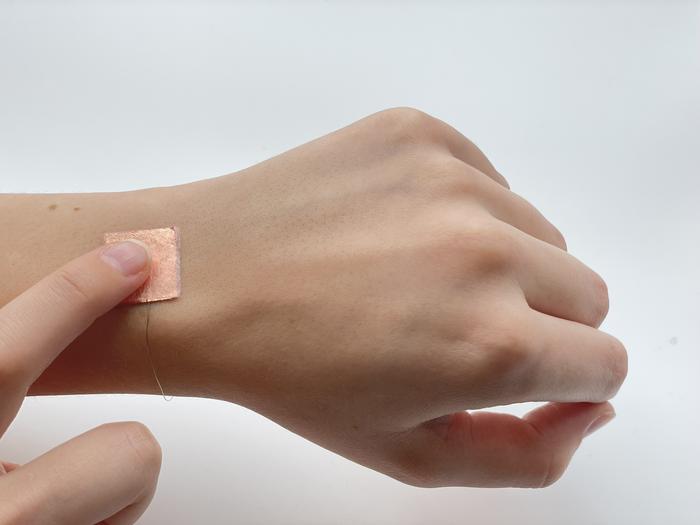
Researchers at North Carolina State University have made groundbreaking advancements in wearable technology, focusing on the dual benefits of generating electricity from human movement while enhancing user comfort. This innovative work centers on a class of molecules known as amphiphiles, which are well-known for their ability to reduce friction and can be effectively utilized in consumer products. Their findings not only demonstrate the feasibility of creating energy from friction but also facilitate the design of materials that feel comfortable against the skin, which is a critical factor in wearable tech.
The study’s approach begins with an in-depth understanding of amphiphiles, substances that can alter the properties of materials through their unique molecular structure. Traditionally found in consumer goods like diapers, amphiphiles mitigate chafing by providing a slippery surface. The research team sought to couple this friction-reducing quality with the capacity to harvest energy. The work involved creating a model designed specifically to analyze the interaction between different amphiphiles and a range of materials, offering insights into how these interactions could be manipulated for practical applications.
Lilian Hsiao, a leading expert in chemical and biomolecular engineering, expressed the primary goal of the research: to create a frictions model capable of elucidating how different amphiphiles impact surface properties. This model serves a dual purpose. Firstly, it provides fundamental understanding necessary for tailoring materials to specific applications; secondly, it lays the groundwork for integrating amphiphiles into haptic energy harvesters. By generating energy through friction while simultaneously ensuring comfort, the researchers are ushering in a new era of wearable technologies.
The experimental phase unveiled astonishing potential. When amphiphiles were incorporated into wearable materials, the researchers discovered a significant increase in energy generation without compromising comfort. In essence, they created fabrics with a slippery quality, significantly enhancing user experience. This breakthrough has profound implications not just for the comfort of wearable devices, but also for their functionality, as the ability to generate up to 300 volts through the wearer’s movements suggests a transformative advancement in personal technology.
Moreover, certain amphiphiles possess electron-donating properties that allow for an additional layer of functionality. Upon integrating these unique amphiphiles into their materials, the researchers made a commendable stride— creating garments that are comfortable against the skin and capable of producing electricity through simple human movement. This capability transforms the way we think about energy harvesting in wearable devices, addressing long-standing challenges in the industry concerning sustained power in wearable technology.
While the concept of harvesting energy from human movement is not new, the researchers highlight a critical gap in the market for long-wear devices. Existing technologies often achieve only short-term energy generation and fail to prioritize user comfort for extended periods. Hsiao points out this chasm, stressing the significance of their findings. The amphiphile-based materials have the potential to change this landscape dramatically by allowing for wearables that are both practical and user-friendly.
The research published in the peer-reviewed journal “Science Advances” details the methodology and outcomes of their innovative approach. Their paper emphasizes the importance of achieving an optimal balance between the friction necessary for energy generation and the comfort demanded by users. Saad Khan, another key figure in the project, is optimistic about further applications of amphiphile materials. He envisions a future where existing haptic devices incorporate this new chemistry to enhance both function and comfort.
The implications of this research are vast. As society increasingly integrates technology into everyday life, the need for wearables that provide significant utility without compromising user experience is essential. With demonstrations of 300 volts generated from movements, the potential applications range from powering small electronics to integrating these materials into health-monitoring devices that require consistent energy input.
Future developments may see these amphiphiles being applied beyond simple wearables. Imagine sports gear that can generate energy while tracking performance metrics, or smart clothing that charges devices while ensuring the wearer experiences no discomfort. The versatility of amphiphile chemistry not only allows for enhanced function but creates a wealth of opportunities for innovative applications across various industries.
The collaborative effort that led to this research highlights the intersection of academic excellence and practical application. Supported by grants from the National Science Foundation, the Dreyfus Foundation, and others, the research exemplifies how academia can lead the charge in solving real-world problems. Their findings are just the beginning, as they seek industry partners who can help translate this research into consumer products.
As sections of society embrace wearable technology, the fusion of comfort and utility presents a compelling narrative. The researchers, now examining the commercial possibilities, harbor hope that their innovations can contribute to smart textiles and energy-harvesting garments that fulfill a growing demand for sustainable, user-friendly technology. This venture not only signals an essential pivot in the world of wearable devices but also ignites conversation about the future of personal technology.
In summary, the research on amphiphiles illustrates the remarkable possibilities inherent in merging technology with human-centered design. Comfort is an essential aspect of wearable devices, and as researchers continue to explore amphiphile chemistry, the potential exists for creating wearable technologies that improve quality of life while reducing dependence on traditional energy sources.
This work, firmly rooted in experimental studies, lays the groundwork for what could become a revolution in wearable technologies, ensuring that this innovative approach not only addresses the fundamental needs of users but aligns perfectly with the evolving landscape of personal electronics.
Subject of Research: Wearable technology and energy harvesting
Article Title: Compressing slippery surface-assembled amphiphiles for tunable haptic energy harvesters
News Publication Date: 15-Jan-2025
Web References: DOI link
References: TBD
Image Credits: Pedro Henrique Wink Reis, NC State University
Keywords
Wearable technology, amphiphiles, energy harvesting, comfort, friction, smart textiles, haptic devices, North Carolina State University, sustainability, personal electronics.





